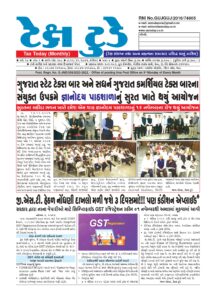GST WEEKLY UPDATE :20/2024-25 (18.08.2024) By CA Vipul Khandhar

-By CA Vipul Khandhar, Ahmedabad
- CBIC direct to CGST Commissionerate: a self-contained reference to the relevant policy wing of the Board for the interpretation or classification issue raised by investigation, audit Commissionerate before issuance of SCN: Instruction No. 03/2024-GST dated August 14, 2024:
Advising that during audits, if a CGST Audit (Pr.) Commissioner encounters issues involving differing interpretations of the CGST Act due to prevalent trade practices, the Zonal (Pr.) Chief Commissioner should refer the matter to the Board’s policy wing. This aims to ensure uniformity and reduce litigation risks. This procedure, outlined in para 2(g) of Instruction No. 01/2023-24-GST, applies to ongoing and future audit cases.
The undersigned is directed to say that the Board’s Instruction No. 01/2023-24-GST (Inv.) dated 30-03-2024 has been issued providing guidelines for maintaining ease of doing business while engaging in investigation with regular taxpayers. The para 2(g) of said Instruction is –
“The scenario may arise in a CGST Zone where an issue investigated by one of the (Pr.) Commissioners is based on an interpretation of CGST Act/ Rules, notifications, circulars etc, and it is in the direction of proposing non-payment or short payment of tax, however, the background is that the taxpayer(s) is/are following, or have followed, a prevalent trade practice based on particular interpretation on that issue in the sector/industry. This scenario results in more than one interpretation and likelihood of litigation, change in practice etc.
- Appeal can be filed manually if not able to file online:
The Kerala GST Department issued Notification No. 3/2024-State Tax dated August 13, 2024 regarding the State Tax in the cases where the taxpayer already filed appeal in form APL01 against DRC03, the Proper Officers are enabled to file APL-03 manually against the same DRC-03 if online filing is technically not possible.
- Manner of penalty calculation under IGST Act, 2017 for the show cause notices issued under section 73(1)/74(1) of the KSGST Act, 2017:
The Kerala SGST Policy Division vide Circular No.12/2024-Kerala SGST dated August 13, 2024:
It has come to the notice that field formations require clarity in the computation and imposition of penalty under the fourth proviso of Section 20 of the Integrated Goods and Services Tax (IGST) Act, 2017 in cases where tax is being demanded under Section 73(1)/74(1) of the Kerala Goods and Services Tax (KSGST) Act, 2017.
In terms of 4th proviso to Section 20 of the IGST Act, the amount of penalty to be quantified/levied is the sum total of the amount of penalty “leviable” under the CGST Act plus the SGST Act. As such, there is no independent provision of its own under the IGST Act to quantify the amount of penalty; it arrives at such quantification through the provisions of the CGST and the SGST Acts.
As per 4th proviso of Section 20 of IGST Act, the penalty leviable under the IGST Act would be the sum total of the quantum of penalty to be levied under the CGST Act and the SGST Act. This is clarified with an Illustration worked out as under:
Illustration: For a service attracting 18% rate of tax, the tax levied under CGST is at the rate of 9% and that under SGST is at the rate of 9%. If it becomes an intra-state supply, the penalty to be levied on each Act is 10% as per section 73(9) of the CGST and the SGST Acts. (i.e., Taxable value x 9% x 10%). Now, applying these rates to the above clause of the IGST Act
Provided also that in cases where the penalty is leviable under the Central Goods and Services Tax Act (i.e., Taxable value x 9% x 10%) or the State Goods and Services Tax Act (i.e., Taxable value x 9% x 10%), the penalty leviable under this Act shall be the sum total of the said penalties ((Taxable value x 9% x 10%) + (Taxable value x 9% x 10%))
Therefore, the penalty is (CGST (Taxable value x 9% x 10%) + SGST (Taxable value x 9% x 10%)), which is equal to 10% of (9% + 9%), i.e., which is equal to 10% of 18%. In short, the ‘penalty’ is ten per cent of tax amount under IGST Act.
- Guidelines for Second special All-India Drive against fake registrations vide Instruction No. 02/2024-GST dated August 12, 2024:CBIC
A second special All-India drive against fake registrations may be conducted by all Central and State tax authorities for a period of two months starting from 16th August 2024.
In the light of above, in partial modification of the Instruction No. 01/2023-GST dated 04.05.2023, the following guidelines are issued for such concerted action on suspicious/ fake registrations during the special All-India drive during this year:
- a) Period of Special Drive:
The second Special All-India Drive may be launched by all Central and State Tax administrations from 16th August 2024 to 15th October 2024 to detect suspicious/ fake GSTINs and to conduct requisite verification and further remedial action to weed out these fake billers from the GST eco-system and to safeguard Government revenue.
- b) Identification of fraudulent GSTINs:
GSTN, in coordination with Directorate General of Analytics and Risk Management (DGARM), CBIC, will identify suspicious/ high-risk GSTINs, based on detailed data analytics and risk parameters, for the purpose of verification by the State and Central Tax authorities during the said drive and share the details of such suspicious GSTINs, jurisdiction wise, with the concerned tax administration. In case of such suspicious GSTINs falling under the jurisdiction of Central Tax, the details will be shared with the Central Tax authorities by GSTN through DGARM. Besides, the State and Central Tax Authorities, may, at their own option, supplement this list by data analysis/ intelligence gathering at their end, using various available analytical tools like BIFA/ GAIN, ADVAIT, NIC Prime, E-Way Bill Analytics etc., as well as through human intelligence, modus operandi alerts, experience gained through the past detections, as well as the first special All-India drive.
c) Action to be taken by field formations:
- On receipt of data from GSTN, a time bound exercise of verification of the suspicious GSTINs shall be undertaken by the concerned jurisdictional tax officer(s). If, after detailed verification, it is found that the taxpayer is non-existent and fictitious, then the tax officer may immediately initiate action for suspension and cancellation of the registration of the said taxpayer in accordance with the provisions of section 29 of CGST Act, read with the rules thereof.
- Further, the matter may also be examined for blocking of input tax credit in Electronic Credit Ledger as per the provisions of Rule 86A of CGST Rules without any delay. Additionally, the details of the recipients to whom the input tax credit has been passed by such non-existent taxpayer may be identified through the details furnished in FORM GSTR-1 by the said taxpayer.
iii. Where the recipient GSTIN pertains to the jurisdiction of the said tax authority itself, suitable action may be initiated for demand and recovery of the input tax credit wrongly availed by such recipient on the basis of invoice issued by the said non-existent supplier, without underlying supply of goods or services or both.
- In cases where the recipient GSTIN pertains to a different tax jurisdiction, the details of the case including the details of the recipient GSTIN, along with the relevant documents/ evidence, may be sent to the concerned tax authority, as early as possible, in the format mentioned in Annexure-B. For sharing such details/ information and coordination with other tax authorities, GSTN Back Office has an online functionality, namely, ‘Initiate Enquiry’ in the Enforcement module, which is available to all tax officers who have been assigned the role of ‘Enforcement Officer’ on the Back Office (BO Portal).
- For the purpose of communicating this information to the recipient tax jurisdiction, a nodal officer shall be appointed immediately by each of the Zonal CGST Zone and State. The name, designation, phone number/ mobile number and E-mail Id of such Nodal officer(s) appointed by CGST Zones and States must be shared by the concerned tax authority with GST Council Secretariat within three days of issuance of this letter. GST Council Secretariat will compile the list of the Nodal officers after procuring the details from all the tax administrations and will make the compiled list available to all the tax jurisdictions and to GSTN.
- The nodal officer of the tax jurisdictions may be assigned the role of ‘Enforcement Officer’ on the BO Portal. Wherever the details of the recipient GSTIN needs to be shared to other tax jurisdiction, the same may be done through the nodal officer. The said nodal officer will accordingly share the information about the recipient GSTIN with the nodal officer of the concerned recipient tax administration, through the said functionality, attaching a pdf document in the format mentioned in Annexure-B. The nodal officer of the recipient tax administration will further share the details with the concerned jurisdictional tax officers, for necessary action.
- GSTN will issue detailed guidelines/ advisory regarding usage of this functionality, which may be referred to. viii. Action may also be taken to identify the masterminds/ beneficiaries behind such fake GSTIN for further action, wherever required, and also for recovery of Government dues and/ or provisional attachment of property/ bank accounts, etc. as per provisions of section 83 of CGST Act. Further, during the investigation/ verification, if any linked suspicious GSTIN is detected, similar action may be taken/ initiated in respect of the same.
- AAR & Important Judgements:
(i) The Hon’ble Gujarat High Court Decision Regarding 12% GST is applicable on geo membranes.
(Applicant – Ananta Synthetic Innovations & Anr. Versus State Of Gujarat & Ors.)
The court observed that the product manufactured by the petitioner being Geo Membrane is classifiable would fall under Chapter 59 and not under Chapter 39 as held by the respondent, the Gujarat Advance Ruling Authority relying upon the decision of the Madhya Pradesh High Court in case of Raj Packwell Ltd. The petitioner, therefore, is liable to pay the 12% GST from 15.11.2017 onwards and not 18%.
The court directed the authority to apply the discounted rate of 12% of the GST on the product manufactured by the petitioner under HSN Code 59111000 of the Tariff. The petitioner is entitled to claim the refund on the excess GST @ 6% paid pursuant to the order of the respondent, the Gujarat Advance Ruling Authority, without claiming any interest.
Disclaimer:
This publication contains information for general guidance only. It is not intended to address the circumstances of any particular individual or entity. Although the best of endeavour has been made to provide the provisions in a simpler and accurate form, there is no substitute to detailed research with regard to the specific situation of a particular individual or entity. We do not accept any responsibility for loss incurred by any person for acting or refraining to act as a result of any matter in this publication.
(Author is well known Chartered Accountant practicing at Ahmedabad on direct and indirect taxes)





